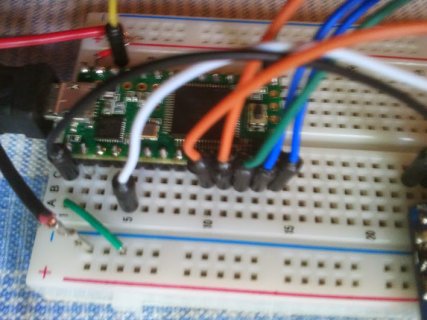/*********************************************************************
This is an example for our nRF8001 Bluetooth Low Energy Breakout
Pick one up today in the adafruit shop!
------> [url]http://www.adafruit.com/products/1697[/url]
Adafruit invests time and resources providing this open source code,
please support Adafruit and open-source hardware by purchasing
products from Adafruit!
Written by Kevin Townsend/KTOWN for Adafruit Industries.
MIT license, check LICENSE for more information
All text above, and the splash screen below must be included in any redistribution
*********************************************************************/
// This version uses the internal data queing so you can treat it like Serial (kinda)!
#include <SPI.h>
#include "Adafruit_BLE_UART.h"
// Connect CLK/MISO/MOSI to hardware SPI
// e.g. On UNO & compatible: CLK = 13, MISO = 12, MOSI = 11
#define ADAFRUITBLE_REQ 10
//#define ADAFRUITBLE_RDY 2 // This should be an interrupt pin, on Uno thats #2 or #3
#define ADAFRUITBLE_RDY 9 // This should be an interrupt pin, on Uno thats #2 or #3
//#define ADAFRUITBLE_RST 9
#define ADAFRUITBLE_RST 17
#define MEMCS_N 22
Adafruit_BLE_UART BTLEserial = Adafruit_BLE_UART(ADAFRUITBLE_REQ, ADAFRUITBLE_RDY, ADAFRUITBLE_RST);
/**************************************************************************/
/*!
Configure the Arduino and start advertising with the radio
*/
/**************************************************************************/
void setup(void)
{
pinMode(MEMCS_N, OUTPUT);
Serial.begin(9600);
delayMicroseconds(300000); // Delay added so serial message shows up on monitor after reset
Serial.println(F("Adafruit Bluefruit Low Energy nRF8001 Print echo demo"));
BTLEserial.begin();
}
/**************************************************************************/
/*!
Constantly checks for new events on the nRF8001
*/
/**************************************************************************/
aci_evt_opcode_t laststatus = ACI_EVT_DISCONNECTED;
int printmessages = 0;
void loop()
{
digitalWrite(MEMCS_N, HIGH); // hold the memory CS_N high to avoid bus contention
// Tell the nRF8001 to do whatever it should be working on.
BTLEserial.pollACI();
if (printmessages < 10) {
Serial.print(printmessages,DEC);
Serial.print(" Last status = 0x");
Serial.print(laststatus, HEX);
Serial.print(F("\n"));
printmessages++;
}
// Ask what is our current status
aci_evt_opcode_t status = BTLEserial.getState();
// If the status changed....
if (printmessages < 10) {
Serial.print(F("Status = 0x"));
Serial.print(status, HEX);
Serial.print(F("\n"));
//delayMicroseconds(1000000);
}
if (status != laststatus) {
// print it out!
if (status == ACI_EVT_DEVICE_STARTED) {
Serial.println(F("* Advertising started"));
}
if (status == ACI_EVT_CONNECTED) {
Serial.println(F("* Connected!"));
}
if (status == ACI_EVT_DISCONNECTED) {
Serial.println(F("* Disconnected or advertising timed out"));
}
// OK set the last status change to this one
laststatus = status;
}
if (status == ACI_EVT_CONNECTED) {
// Lets see if there's any data for us!
if (BTLEserial.available()) {
Serial.print("* "); Serial.print(BTLEserial.available()); Serial.println(F(" bytes available from BTLE"));
}
// OK while we still have something to read, get a character and print it out
while (BTLEserial.available()) {
char c = BTLEserial.read();
Serial.print(c);
}
// Next up, see if we have any data to get from the Serial console
if (Serial.available()) {
// Read a line from Serial
Serial.setTimeout(100); // 100 millisecond timeout
String s = Serial.readString();
// We need to convert the line to bytes, no more than 20 at this time
uint8_t sendbuffer[20];
s.getBytes(sendbuffer, 20);
char sendbuffersize = min(20, s.length());
Serial.print(F("\n* Sending -> \"")); Serial.print((char *)sendbuffer); Serial.println("\"");
// write the data
BTLEserial.write(sendbuffer, sendbuffersize);
}
}
}


